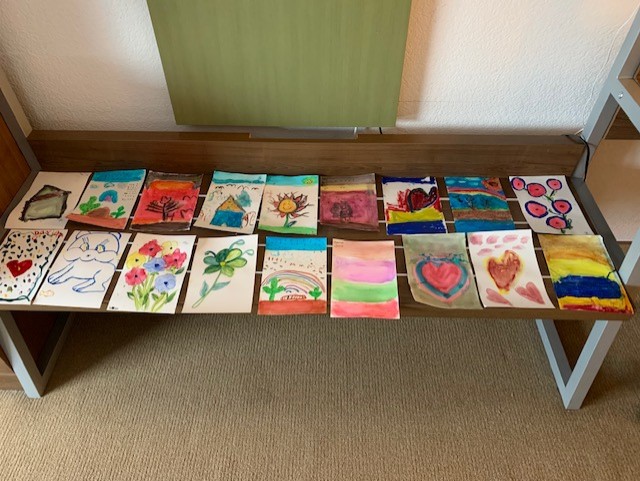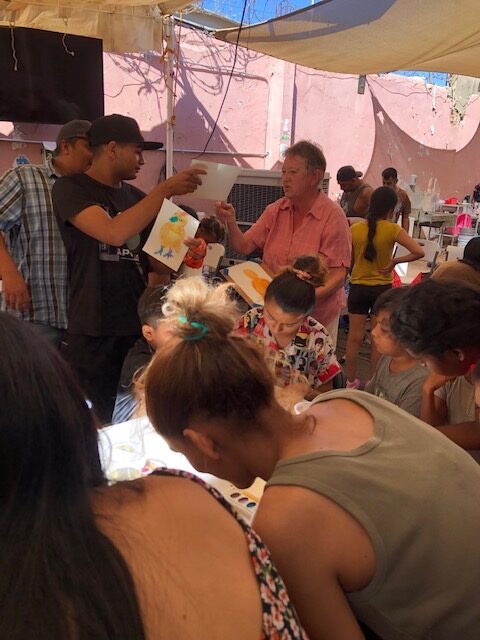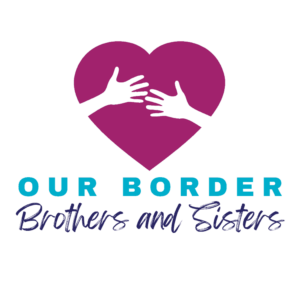by Suzanne Herder, CSJ

My experience at the shelter in Mexicali, Mexico has changed my life. I am now looking at everything and everyone with different eyes.
The experience was not anything I had expected! I thought there would be a building surrounded with a yard where the children could play and we would paint in small groups. Instead, we arrived at a crowded shelter with 215 immigrants—110 adults and 105 children. The shelter is on a busy street where it is not safe for the residents to go outside. There’s no outside play area or equipment, just concrete floors. There are cement rooms surrounding the courtyard where three families share a room. More people sleep in the courtyard. There’s not much to do all day.
The people we met were gracious and anxious to share their stories. The stories broke our hearts. I was there to teach watercolor classes. One 12-year-old boy who knew English and knew how to paint offered to help me. He was afraid to share his real name. His mother, Olga, told me that his father was shot in their home in Mexico in front of the family. With the father dead, mom and her three children were told to get out of their home country or they would be killed too.
I went to the border for the nonprofit Border Compassion founded by Sister Suzanne Jabro, CSJ. Its purpose is to help accompany families seeking asylum in the United States of America. The shelter is a place to wait until they are called for a hearing. Sometimes it takes a year for a family to cross over if they have a sponsor. The wait is longer for those without sponsors. Many are fleeing violence and have family members who have been killed. They are running for their lives with their little children.
Entering the shelter, I saw children and people everywhere! I soon realized the lessons I had planned would have to change. Twenty-five children from ages 2 to 10 years old rushed to the tables to paint before I even set up. With an interpreter, we announced that “babies” had to have their mother or father with them. I showed the painting we were going to do, a make-believe bird, then I took them through the painting step by step and they followed directions. Everyone wanted to hear “¡Bueno!” when they showed me their pictures. After the lesson, they could paint whatever they wanted. Some painted houses. Others painted hearts. One boy wanted to paint a tiger, so that night I had to learn how to paint a tiger!

I taught three groups on the first day, with one special session just for women. Some of the children wanted to continue painting, so they found a place on the floor to paint when their group was finished. I told them we would be back the next day.
When we appeared the next day, we received many hugs before the children ran to the table to get a place to paint, again before I set up. Everyone that wanted to paint got a chance during the morning. It was a joyous atmosphere and very difficult to leave.

It will take time to process everything I saw and experienced. Because the painting was such a success, I want to go back in June. I know we want to help the people in need in our own area, but this is a need too. Can we do both?
If you want to donate, here are some ideas: soft dolls, small cars or trucks, coloring books, crayons, pans of watercolor paints and brushes, inexpensive watercolor paper, adult coloring books, colored pencils, supplies for making jewelry or any other craft items or money for art supplies. To donate, please email Suzanne Herder, CSJ, sherder@csjstpaul.org.

In line with our commitment to defend the rights of migrants, asylum seekers and refugees, our new blog series “Our Border Brothers and Sisters,” we present the stories that our sisters and associates who have had border experiences would like to share. We are grateful to them for their generosity. It is our hope that these stories will open us to seeing and understanding our brothers and sisters in greater depth because, as Colum McCann once said: “You can’t hate someone when you know their story.”